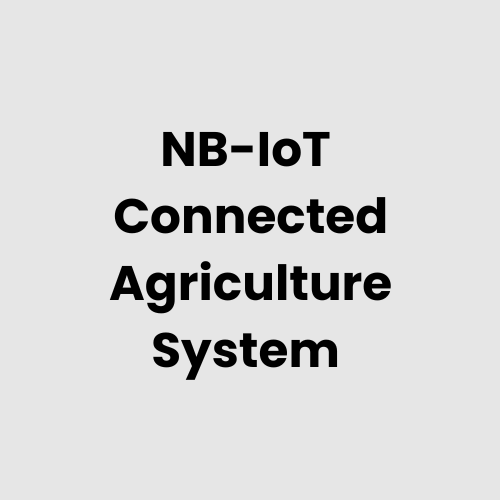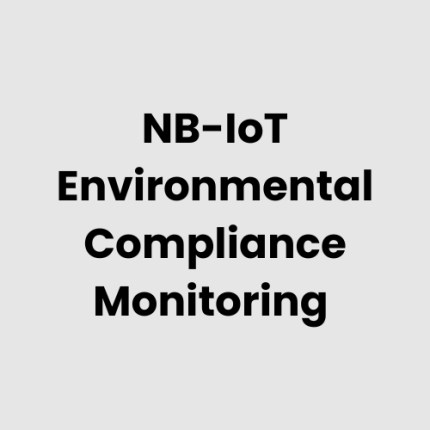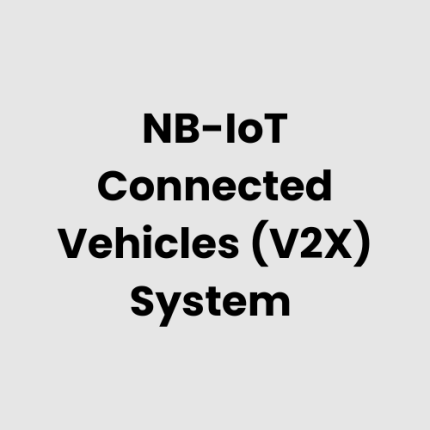Description
Technical Architecture of the NB-IoT Enabled Connected Agriculture System
The NB-IoT Enabled Connected Agriculture System integrates sensors, gateways, and cloud infrastructure to provide real-time monitoring and data-driven insights. The architecture features:
- Edge Devices: Smart sensors for soil moisture, temperature, humidity, and crop health monitoring.
- NB-IoT Gateways: Connect sensors to cellular networks, ensuring long-range, low-power communication.
- Data Processing Layer: Aggregates data from sensors and sends it to cloud platforms for analysis.
- Cloud Integration: Centralized data management for predictive analytics, crop planning, and remote monitoring via dashboards and mobile applications.
- User Interface: Accessible through web portals and mobile apps for farm management, alerts, and reporting.
List of Hardware for the NB-IoT Enabled Connected Agriculture System
- Soil Moisture Sensors: Measure water content to optimize irrigation schedules.
- Temperature and Humidity Sensors: Monitor microclimate conditions.
- Crop Health Sensors: Utilize spectral analysis for plant health assessments.
- Weather Stations: Record atmospheric data such as rainfall and wind speed.
- NB-IoT Gateways: Transmit sensor data to the cloud.
- Drones: Conduct aerial surveys and assess large fields.
- Solar Panels: Provide renewable energy for remote sensors.
- Actuators: Automate irrigation systems and greenhouse controls.
Physical Placement Considerations
- Soil Sensors: Place at root level in key zones for accurate moisture readings.
- Weather Stations: Install in unobstructed areas for precise atmospheric data collection.
- Gateways: Ensure central placement for optimal sensor connectivity.
- Drones: Deploy from locations with clear aerial paths.
- Actuators: Position near irrigation valves or greenhouse mechanisms for quick response times.
Hardware Architecture
The hardware architecture of the NB-IoT Enabled Connected Agriculture System includes:
- Sensor Nodes: Each node features an NB-IoT module, a sensor array, and a power source (e.g., battery or solar panel).
- Gateways: Equipped with NB-IoT modules, they aggregate sensor data and forward it to the cloud.
- Control Units: Manage actuators based on sensor inputs and predefined rules.
- Network Infrastructure: Cellular towers supporting NB-IoT connectivity.
Deployment Considerations
- Network Coverage: Verify NB-IoT cellular coverage in agricultural areas.
- Power Supply: Use solar panels for energy efficiency in remote locations.
- Durability: Ensure hardware is rugged and weatherproof for outdoor conditions.
- Scalability: Design the system to accommodate additional sensors and devices.
- Data Security: Implement end-to-end encryption for all transmitted data.
Relevant Industry Standards and Regulations
- ISO 27001
- IEEE 802.15.4 for low-power communications
- GSM Association NB-IoT Standards
- IoT Cybersecurity Improvement Act
- EPA Regulations for Agricultural Practices
- OMA Lightweight M2M (LwM2M)
Local Server Version
The NB-IoT Enabled Connected Agriculture System can operate with a local server, providing:
- On-Premise Data Storage: Ideal for farms with limited cloud access.
- Low Latency: Real-time processing without reliance on external networks.
- Enhanced Security: Keeps sensitive farm data within local infrastructure.
GAO Tek offers tailored solutions to set up and maintain local servers for seamless operations.
Cloud Integration and Data Management
The cloud integration of the NB-IoT Enabled Connected Agriculture System includes:
- Data Aggregation: Centralized storage of sensor data for historical analysis.
- Machine Learning Models: Predict crop yield, water needs, and potential threats.
- Remote Access: Farmers can monitor and manage farms via web or mobile applications.
- Scalable Infrastructure: Cloud resources grow with increasing data demands.
- Third-Party Integration: Compatible with weather APIs and agricultural databases.
GAO Case Studies of NB-IoT Enabled Connected Agriculture System
USA Case Studies
- Fresno, California
In Fresno, smart soil moisture sensors and NB-IoT gateways transformed irrigation management for vineyards. The system provided real-time data on soil conditions, significantly reducing water usage and enhancing crop yield. GAO Tek’s expertise ensured optimal device deployment and seamless connectivity to cloud platforms for predictive analytics. Learn more about precision agriculture. - Des Moines, Iowa
Cornfields in Des Moines leveraged NB-IoT solutions for automated irrigation and pest monitoring. By integrating weather stations with soil sensors, the system optimized water usage while forecasting pest outbreaks. GAO Tek’s support enabled rapid deployment in this agriculture-focused region. See related insights from the U.S. Department of Agriculture. - Tucson, Arizona
In Tucson, farmers battling arid conditions utilized NB-IoT devices for microclimate monitoring. These tools measured temperature and humidity, ensuring that crops received optimal care. GAO Tek provided robust, weather-resistant hardware for this challenging environment. Explore innovations in smart farming. - Orlando, Florida
Orlando’s citrus groves benefited from NB-IoT technology to combat disease outbreaks. Real-time data from spectral crop health sensors helped identify early signs of infection, improving disease management. GAO Tek facilitated seamless system integration with local agritech platforms. Learn more about IoT in agriculture. - Spokane, Washington
Wheat farms near Spokane implemented NB-IoT-enabled weather stations and drones for large-scale field monitoring. The system tracked rainfall and wind speed to inform planting and harvesting schedules. GAO Tek customized solutions to meet the needs of vast farmlands. Check resources from Washington State University Agriculture. - Amarillo, Texas
Cattle ranches in Amarillo adopted NB-IoT systems for pasture management. Soil sensors monitored grass conditions, ensuring healthy grazing areas for livestock. GAO Tek supported deployment with scalable hardware options tailored to ranchers. Visit Texas A&M AgriLife for more. - Albany, New York
Apple orchards in Albany used NB-IoT gateways and sensors to monitor soil pH and nutrient levels. Farmers leveraged predictive analytics to optimize fertilizer use, improving fruit quality. GAO Tek enabled precise implementation of these cutting-edge tools. Learn more at Cornell University Agriculture. - Fort Collins, Colorado
Greenhouses in Fort Collins used NB-IoT solutions for environmental control. Automated actuators regulated temperature, humidity, and light levels, ensuring ideal conditions for organic farming. GAO Tek’s ruggedized hardware ensured reliability in controlled environments. Explore climate-smart agriculture. - Madison, Wisconsin
In Madison, dairy farms adopted NB-IoT for smart silage monitoring, tracking fermentation processes and moisture content in storage. GAO Tek provided robust devices for accurate, long-term data collection. See resources from UW-Madison Agriculture. - Lubbock, Texas
Cotton fields in Lubbock integrated NB-IoT solutions for real-time irrigation scheduling. Soil moisture sensors prevented overwatering, conserving precious groundwater resources. GAO Tek’s technical expertise ensured seamless deployment. - Nashville, Tennessee
Nashville’s soybean fields utilized NB-IoT to detect weather anomalies and optimize planting schedules. Integrated weather stations and cloud platforms provided actionable insights. GAO Tek delivered reliable connectivity solutions for remote rural areas. - Sacramento, California
Rice paddies near Sacramento deployed NB-IoT sensors for water-level monitoring. Farmers achieved efficient water use, reducing environmental impact. GAO Tek supported the initiative with long-range, energy-efficient hardware. - Bismarck, North Dakota
In Bismarck, barley farms employed NB-IoT systems for frost prediction, safeguarding crops against sudden temperature drops. GAO Tek provided ruggedized solutions suited for harsh weather conditions. - Phoenix, Arizona
Greenhouses near Phoenix integrated NB-IoT-enabled drones for pest monitoring. The system provided aerial imagery and automated pest control alerts. GAO Tek’s modular system design ensured compatibility with existing equipment. - Atlanta, Georgia
Peach orchards in Atlanta adopted NB-IoT solutions for smart irrigation and pest control. Real-time data from moisture and crop health sensors improved orchard management. GAO Tek tailored deployment to meet the region’s specific needs.
Case Studies in Canada
- Saskatoon, Saskatchewan
In Saskatoon, canola farms utilized NB-IoT soil sensors and weather stations to optimize planting and harvesting cycles. GAO Tek provided a robust system to withstand the prairie climate, ensuring reliable performance. Discover insights from Agriculture and Agri-Food Canada. - Guelph, Ontario
Greenhouses in Guelph used NB-IoT solutions for precise climate control and fertilizer application. Automated systems enhanced productivity while minimizing waste. GAO Tek delivered customized hardware and ensured seamless integration with greenhouse systems. Learn more from the University of Guelph Agriculture.
Navigation Menu for NB-IoT
Navigation Menu for IoT
- LORAWAN
- Wi-Fi HaLow
- Z-WAVE
- BLE & RFID
- NB-IOT
- CELLULAR IOT
- GPS IOT
- IOT SENSORS
- EDGE COMPUTING
- IOT SYSTEMS
Our products are in stock and can be shipped anywhere in the continental U.S. or Canada from our local warehouse. For any further information, please fill out this form or email us.
We are actively looking for partners who are like us located in the U.S. and Canada. For more information on partnering with GAO, please visit Partner with GAO Tek Inc. It lists various ways to partner with GAO, such as OEM Partnerships, Technology Integration, Distribution and Reselling Opportunities, Presenting at the Leading Event Tek Summit, Joint R&D Projects, Training and Consulting Services, Industry-Specific Collaborations, Research and Academic Partnerships.



